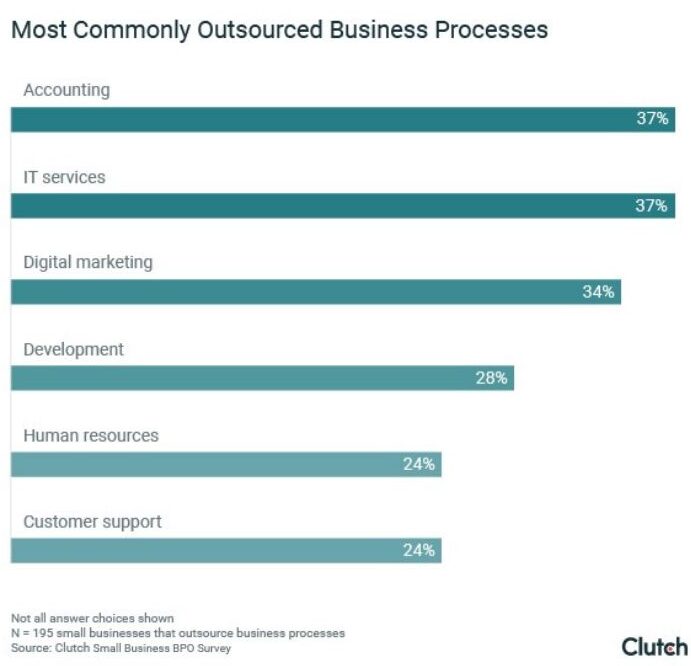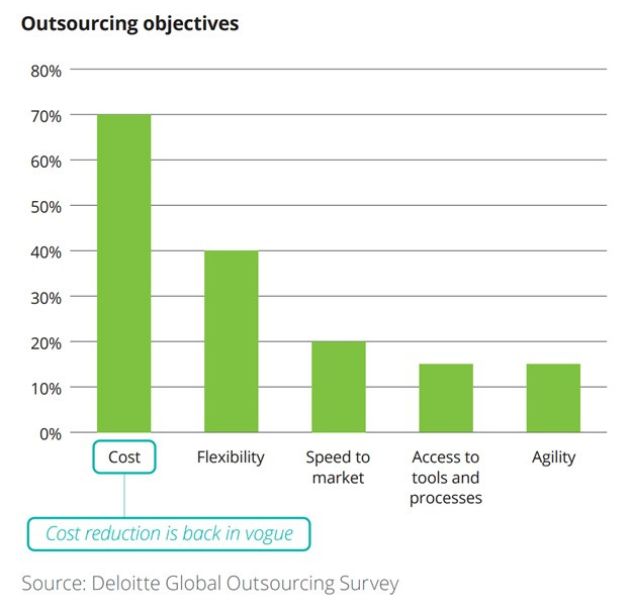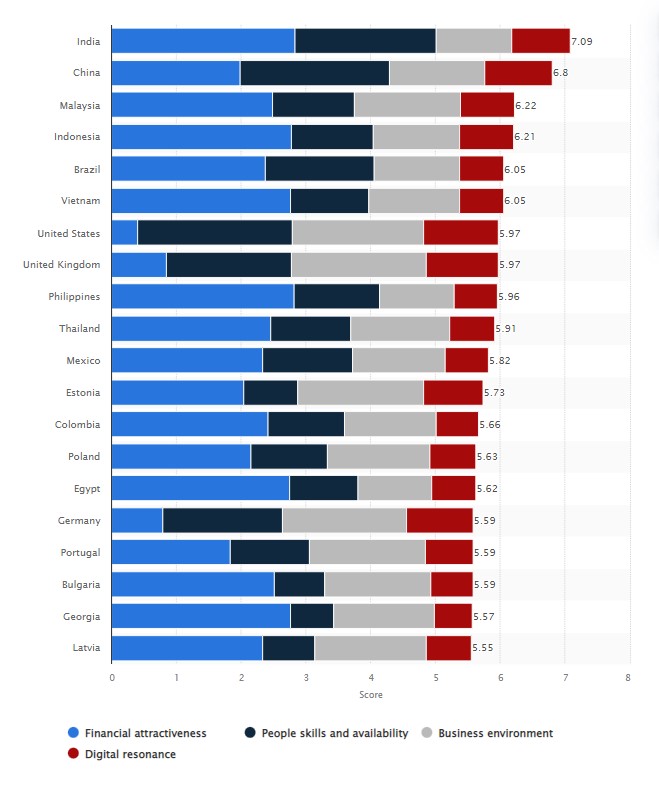After companies reach a certain level of growth, they’re often confronted with a challenging choice — Should they outsource or outstaff?
Regardless of the size or the type of service you’re offering, it’s difficult to do everything on your own when you’re scaling your business. As a result, it becomes necessary to hire teams that can take over certain tasks.
There are several other methods of employment but outsourcing and outstaffing are the most common. It is predicted that the business process outsourcing market is projected to grow at a CAGR of 4% by the end of this year.
On the surface, it’s difficult to tell the difference between the two. And while both have the objectives to minimize financial and personnel costs for the client company, their methods and benefits vary.
Let’s take a look at what each means, their benefits and cons, and what would be the perfect fit for you.
What is Outsourcing?
Outsourcing is defined as the process of hiring a team outside an organization to perform certain services that were traditionally performed in-house.
The outsourcing company is a standalone company that takes care of its employees’ wages, equipment, hiring, and training. The client company just provides them with the tasks and everything else is handled by the manager of the outsourcing company.
Here are some of the business processes that organizations prefer to outsource the most.
Unsure whether you should outstaff or outsource when expanding your business?
Contact Growth Hackers
Let’s take eCommerce companies for instance. As they grow and cover more regions, they’ll need to outsource their eCommerce order fulfillment process to expert third-party logistics providers. Moreover, they may also outsource IT and customer support as their business volumes increase.
A lot of businesses choose to outsource tasks such as customer service, logistics, IT services and management, marketing, supply chain management, content creation, etc. Outsourcing has become a common phenomenon. Around 300k jobs get outsourced out of the USA every year.
It’s because companies are embracing the need for cost-effective global talent and a remote work culture that relies on virtual meetings. It helps companies mitigate the risk by diversifying their delivery sites.
Why Should You Outsource?
Cost Efficiency
For most companies, the cost factor is probably the biggest benefit of outsourcing. What makes a major difference in the cost is the cost-per-hour and reduction in utility expenses.
Higher Productivity
Your teams are no longer bombarded with responsibilities that don’t fall under their job description. They can focus on tasks they’re good at. It also saves up the management’s time in recruiting and hiring talent.
Superior Talent Pool
If you disregard the geographical limitations, you’ll find a massive pool of talent with varying levels of expertise across the globe. These teams can efficiently get your job done at much lower costs. It’s especially beneficial for firms in Western Europe and the USA where labor costs are high.
Cons of Outsourcing
Limited Management Authority
Since the outsourcing team falls under their project manager, you have little to no say in how you want to get things done. There’s a possibility that the end product will not be up to your expectations.
Limited Visibility
If you choose to outsource, understand that there’ll be no real contact with the employees and you won’t be in the loop. There are high chances that there’ll be a lack of transparency with the project and you won’t know how the work is coming along until it’s done.
What is Outstaffing?
In case of outstaffing, you hire the remote team which is fully at your command. It’s basically an extension of your team. The client employs the outstaff team while the outstaffing service provider acts as the official employer that takes care of the payroll, benefits, bonuses, types of equipment, etc. Rather than working on a project basis, an outstaff team would be dedicated to just a single client.
There are two types of outstaffing techniques that companies usually adopt:
Leasing Staff: When the contractual agreements occur for more than 3 months
Temporary Staff: When the requirement is short term and the contracting agency and executing organization get into an agreement for a project ranging from one week to three months.
Let’s consider the example of a tech start-up in the US that needs to grow its iOS development team. It needs qualified candidates but it’s experiencing extremely high costs in terms of hiring and the average salaries. Being a new name in the industry also means it lacks the goodwill and brand name that draws qualified candidates.
As a result, it looks for developers in India and hires talent from there. They negotiate a contract with an Indian tech firm for iOS developers. The start-up hires and shortlists qualified team members. As the development team grows, it then adds QA engineers and eventually, it expands into a full-fledged development center.
Most Western Europe and US firms outstaff to countries in Eastern Europe or Southeast Asia to save on costs. Check out the leading countries in offshore business services worldwide last year.
Outstaffing is an ideal way if you want to rapidly scale your teams and also an amazing alternative for a task that requires specific experience and skills.
Start outstaffing or outsourcing your company’s needs today!
Why Should You Outstaff?
Flexible Hiring Model
Even though you’re building a remote team, you get to dictate the hiring process. You have the flexibility in terms of hiring the right people, adjusting their schedules, and deciding who’ll do what.
Higher Control of Management
Subsequently, the outstaffing model provides you with a higher level of control and involvement. More than hiring the right people, you’re also acting as the project manager. So you have a say in the speed and quality of the work and get to set the deadlines.
Cost Efficiency
Just like outsourcing, outstaffing significantly reduces the expense of hiring staff in your country. It offers you a kick-start by getting a full-fledged team working for you in no time. In fact, since you’re taking over the project management activities the cost will be even lower than outsourcing.
Cons of Outstaffing
Complete Responsibility for Project Management
Just like having a lack of responsibility is a drawback, having too much responsibility is one too. While outstaffing, if the project doesn’t work out, it’s completely on you to take the blame.
Communication Problems
Outstaffing is subjected to a lot of communication issues. This isn’t just because of the time differences but also because of the cultural and language barriers. It becomes crucial to establish a seamless communication channel such as Zoom where these challenges can be addressed.
Outsourcing or Outstaffing – What Should You Choose?
Now that we understand the two better, let’s take a step closer to deciding which one to choose.
The truth is there’s no straightforward answer. The choice depends on a lot of factors. But you can nevertheless get clarity on where you stand and make a decision for yourself.
Listed below are some of the top things to consider before you choose between outsourcing and outstaffing.
What is your Budget?
Even though the motive of both outsourcing and outstaffing is to reduce expenses, you can gauge that outsourcing is comparatively more expensive than outstaffing. With outsourcing, you aren’t just handing over tasks but also management responsibilities.
So, if you have a budget that covers the expenses, go for outsourcing since you won’t have to spend extra time overseeing the tasks.
However, if you’re just starting out, go for outstaffing. It will help you establish a strong foundation with the remote team by being involved with their day-to-day tasks and also save costs on management.
What is the level of your Technical Skills?
Outsourcing doesn’t require you to have any technical skills since the outsourcing agency’s project head deals with explaining the tasks to the teams. You just need enough skills to formulate the requirements for your future product. But it’s different when you’re outstaffing. Since you’ll directly be managing a team of experts, you need to have sufficient knowledge yourself.
How much time do you have?
Let’s say you even possess the technical skills, but if you don’t have the time, you cannot opt for outstaffing. Your remote team will directly rely on you for instructions and the delegation of tasks. However, if you cannot invest the time needed, outsourcing is your best bet.
What is the duration of your Project?
Outstaffing is for you if you have long-term needs that need day to day control of the vendor team. Whereas, outsourcing is better if you have short-term needs that require immediate and cheap services from vendors.
Final Thoughts About Outstaffing vs Outsourcing – Which One to Choose to Grow Your Business
Of course, there’ll be a lot of other factors that you need to consider depending on the type and nature of your business. And while both types of employment have their benefits and drawbacks, it all boils down to your individual goals. There’s no good or a bad model. Each case is unique so as long as the model aligns with your objectives, it will be effective.
Growth Hackers is an experienced small business branding company helping businesses from all over the world grow. There is no fluff with Growth Hackers. We help entrepreneurs and business owners in outsourcing or outstaffing their digital marketing works, increase their productivity, generate qualified leads, optimize their conversion rate, gather and analyze data analytics, acquire and retain users and increase sales. We go further than brand awareness and exposure. We make sure that the strategies we implement move the needle so your business grow, strive and succeed. If you too want your business to reach new heights, contact Growth Hackers today so we can discuss about your brand and create a custom growth plan for you. You’re just one click away to skyrocket your business.







